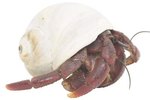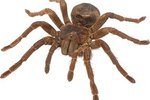
Chilean rose hair tarantulas, sometimes just called rose hair tarantulas or Chilean rose tarantulas (Grammostola rosea), are among the most widely available spiders in the pet trade, probably because they have peaceful natures, although some individuals make determined efforts to escape. They aren’t especially demanding in terms of care, either.
Housing
The most appropriate housing for a tarantula is a glass or plastic terrarium. A wire mouse cage might contain her, but it won't contain prey, its bars are a leg-tangling hazard and it won't retain humidity, so it is not suitable. Chilean rose hairs don’t need a huge tank; one of about 10 to 15 gallons is fine for an adult. As they are not especially social, don't keep more than one per tank -- even the largest tank is too small to allow two or more spiders to establish separate territories.
Substrate
Chilean rose hairs burrow, so half-fill the tank with a suitable substrate. Exotic pet suppliers provide several options, including coconut fiber. Chemical-free potting compost is also fine. If you want to use soil from the garden, sift it first and then bake it for at least 20 minutes at about 200 degrees Fahrenheit to kill bacteria, fungi and other pathogens and pests. It is advisable to sterilize other substrates in this manner as well, especially those from pet stores that sell invertebrates.
Accessories
A shallow water bowl is the only other essential for the tank -- tarantulas don't need a food bowl because they eat live invertebrates. The single optional accessory that your tarantula would most appreciate is somewhere to hide, perhaps a hollow log, a large piece of bark or a purpose-made plastic shelter. Other accessories are perhaps more for you than her, although moss is useful for helping to maintain the correct humidity. If you wish to introduce growing plants, ensure that they are not dangerous to tarantulas first, and have them in pots sunk into the substrate, so you don’t need to uproot them when cleaning the tank.
Temperature and Humidity
Normal room temperature is usually fine for a Chilean rose hair. However, if the tank is in a cold room, use a reptile heat mat for extra warmth. Position the mat under one end of the tank and aim for a temperature of about 75 to 80 degrees F at the warm end. Relative humidity should be between 70 percent and 75 percent. Raise it as required by misting the tank and moistening the substrate with distilled or bottled water.
References
Photo Credits
-
Tom Brakefield/Stockbyte/Getty Images
Writer Bio
Judith Willson has been writing since 2009, specializing in environmental and scientific topics. She has written content for school websites and worked for a Glasgow newspaper. Willson has a Master of Arts in English from the University of Aberdeen, Scotland.




